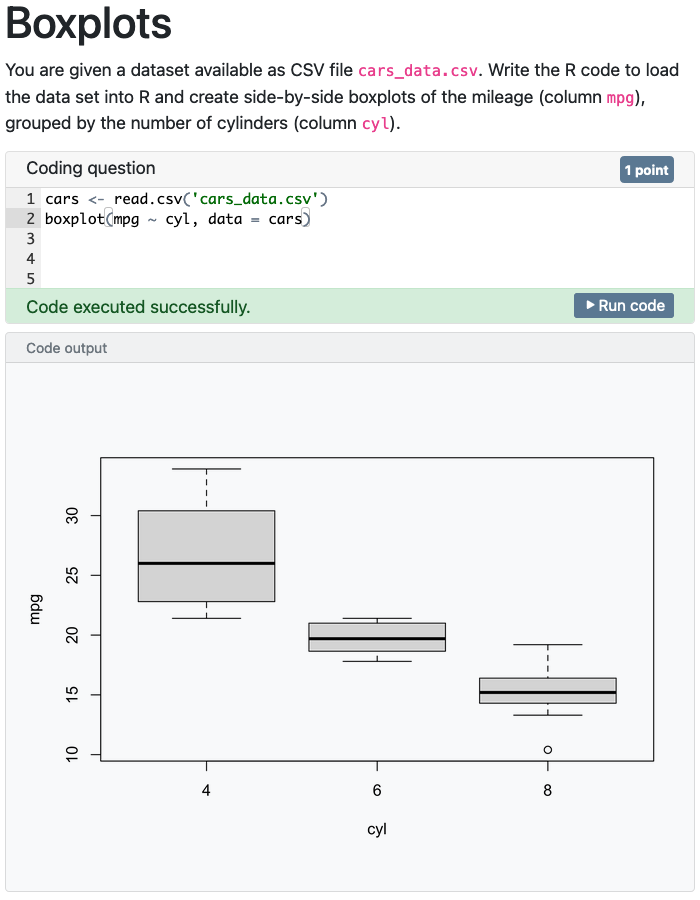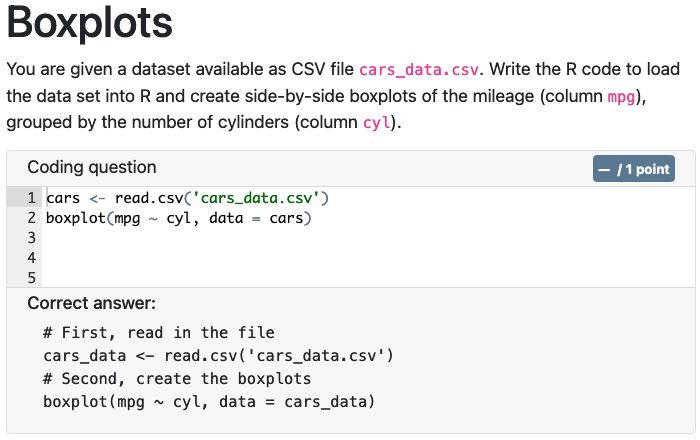Coding exercises allow you to incorporate assessing R coding skills in your exams. Exercises are modeled after the concept with the same name in the learnr package. Although there are many similarities between exercises in examinr and learnr, there are also some important differences, which are highlighted below to avoid issues.
Using exercises in exams
Using exercises in an exam document is as simple as adding an R code
chunk to the document, with chunk option exercise=TRUE, for
example:
The user would see this as

The code in the exercise chunk is pre-filled in the editor, but will not be evaluated automatically. The code will only be evaluated when the user clicks the Run code button.
Difference to learnr: user code has access only to the environment created by the exercise data provider. User code does not have access to any R objects from the R markdown document.
Setup and solution chunks
Exercises can reference other R code chunks in the document by their label to be used as setup code or solution. Neither setup nor solution chunks will be evaluated when rendering the document, but are extracted for later use.
Setup chunks are run immediately before the user code in the exact same environment. This is useful for preparing the environment (e.g., creating files or transforming data). Setup chunks can also create output (if the chunk options are set accordingly) which is included in the output of the user code. It is important to know that the setup chunk, just like user code, doesn’t have access to the environment of the exam document. Both are completely separated. Furthermore, the state of the random number generator in the setup chunk is not determined by the current attempt. As such, randomization in the setup chunk is not reproducible. Any randomization must be done in the exercise data provider, as explained in the companion vignette on randomizing exams.
Solution chunks are currently only used for feedback and are not intended for grading the user code. They are never evaluated.
# Boxplots
You are given a dataset available as CSV file `cars_data.csv`.
Write the R code to load the data set into R and create side-by-side boxplots
of the mileage (column `mpg`), grouped by the number of cylinders (column `cyl`).
```{r q_2-setup}
# The code in the setup chunk is run immediately before the user code.
# We can, for instance, write data to a file which is accessible by the user code.
write.csv(mtcars, file = 'cars_data.csv', row.names = TRUE)
```
```{r question_2, exercise=TRUE, exercise.setup='q_2-setup', exercise.solution='q_2-sol'}
```
```{r q_2-sol}
# First, read in the file
cars_data <- read.csv('cars_data.csv')
# Second, create the boxplots
boxplot(mpg ~ cyl, data = cars_data)
```During the exam, the user would only see the exercise chunk and have access to the environment transformed by the setup chunk:

The code from the solution chunk will be shown on the feedback page:

Configuration
Exercise chunks can be configured via chunk options or globally via
the exam_configuration() function. Options set as chunk
options must be prefixed with exercise. and take precedence
over the global configuration. For example setting the time-limit to 10
seconds for all exercises can be done via
exercise_options(timelimit = 10), while adding the chunk
option exercise.timelimit=10 to an exercise chunk changes
the time limit only for this one exercise.
The supported options are
| Option | Description | Default value |
|---|---|---|
points |
the number of points the exercise is worth | 1 |
setup |
label of an R code chunk which is evaluated before the user code | none |
solution |
label of an R code chunk holding the solution to the exercise code chunk | none |
timelimit |
time limit for the code to run (in seconds) | 5 |
title |
title of the exercise |
exercise$panelTitle from
status_messages()
|
button |
label of the run exercise button |
exercise$buttonLabel from
status_messages()
|
label |
a label to help screen readers describe the purpose of the input element |
exercise$label from
status_messages()
|
lines |
the minimum number of lines in the code editor | 5 |
autocomplete |
enable or disable auto-completion in the code editor | TRUE |
df_print |
method used for printing data frames created by the user code | Inherited from the document |
Some options only make sense when set for a particular exercise
chunk, especially exercise.solution. Several exercise
chunks can share the same setup chunk.
Difference to learnr: note that examinr does not use
the label of code chunks to determine setup and solution chunks. An
exercise only uses the setup/solution chunk set via
exercise.setup and exercise.solution.
Evaluating user code
User code is evaluated on the server which raises security and performance issues. By default, examinr uses the future package for evaluating the user code, possibly asynchronously.
The examinr package sanitizes the environment variables to avoid possibly leaking secrets and other sensitive information to user code, but there are currently no other restrictions.
To leverage asynchronous evaluation of user code you must use
future::plan() to configure the future strategy. The
following plan is the minimum recommended for asynchronous evaluation,
but more worker processes may be necessary for exams with heavy
computing:
Writing your own evaluator
The default future_evaluator() function creates a future
according to the specified plan, but you can change the
exercise evaluator with exam_config(exercise_evaluator=).
This would be useful if you want to impose further restrictions on the
evaluation of user code, e.g., stricter limits on hardware limits and
access rights. On Unix systems, you could use functions
rlimit_*() from package unix for setting
resource limits or use RAppArmor for
even more control.
The exercise evaluator is a function taking the arguments specified below and returning a promise object.
| Argument | Description |
|---|---|
expr |
an R expression to evaluate |
envir |
environment in which to evaluate the R expression |
label |
label of the exercise chunk |
timelimit |
configured time limit (in seconds) |
... |
currently not used |
Your exercise evaluator is expected to ensure that the time limit is
adhered to. The expression expr must be evaluated in
envir and the examinr package must be available in the R
process evaluating the expression.